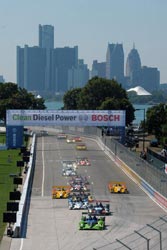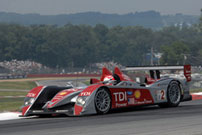Green Racing Initiative
Also see: Green Racing Update: The 2008 ALMS Petit Le Mans Green Challenge™
 EPA420-F-08-031, October 2008
EPA420-F-08-031, October 2008Download PDF version of this fact sheet formatted for print. (X pp, XXK, About PDF Files)
- What is the Goal of Green Racing?
- Why is Racing a Good Tool to Develop Green Technology?
- Who is involved in Green Racing?
- How Does Green Racing Work?
- The American Le Mans Series (ALMS) Green Challenge™
What is the Goal of Green Racing?
The goal of green racing is to use motor sport competition to help rapidly develop cleaner, more fuel efficient vehicle propulsion systems that will eventually be used in consumer vehicles. Technologies initially developed for green race cars can foster faster general introduction of automotive technologies that reduce greenhouse gases, reduce exhaust pollutants, and increase fuel economy. The high level of interest in motor sports could bring this technology to the attention of the public and hasten its acceptance in the new market.
Why is Racing a Good Tool to Develop Green Technology?

Historically, racing competition has been in a unique position to promote the kind of rapid vehicle technology innovation competitors need to keep winning. There is historical precedence of racing resulting in innovations in safety, durability, performance, tire technology, and more. The speed at which technology development occurs in racing is usually much faster than in normal manufacturer product development. Racing also provides the ideal proving ground to assure that technological improvements will be durable under the most demanding conditions.
Race audiences represent a ready market that can help carry the technological innovations to street vehicles. There are millions of racing fans in the U.S. alone who make purchase decisions that are influenced by what they see on the race track. Manufacturers are already motivated by market pressures and regulation to bring about technological improvements, but motor sport overlays a much greater sense of urgency and imagination. There is extreme pressure to turn ideas into hardware for the next racing season. This is an opportunity to harness this motivation for environmental good, much the same as it has been used to develop vehicle safety technology.
Many racing venues are already moving to go greener. Several racing series have also moved to using renewable fuels, such as ethanol. Their motivation is both social responsibility and a desire to make racing more relevant to every day transportation issues in order to retain or increase the fan base. Much of racing today is oriented more toward entertainment than technical innovation. There is a movement to return racing to its roots of being a competition among vehicles that are relevant to street machines.
Who is involved in Green Racing?
The impetus behind Green Racing originated within the Environmental Protection Agency (EPA), and developed into a joint effort that includes Argonne National Laboratories along with the Department of Energy (DOE), vehicle original equipment manufacturers, automotive suppliers, motor sports sanctioning bodies, motor sports associations, and racing vehicle developers. These parties were brought together by SAE International to form the Green Racing Working Group. The Green Racing Protocols, which will be published in 2008 as a SAE technical document, was developed by a small subgroup within the working group, including representatives from EPA and Argonne/DOE. The American Le Mans Series (ALMS) along with its sanctioning body, the International Motor Sports Association, were involved in the working group and will be the first racing series to implement green racing protocols by conducting the ALMS Green Challenge™ competition at their Petit Le Mans race on October 4, 2008.
How Does Green Racing Work?
The Green Racing Protocols can be adapted for any racing series. The protocols promote the development of energy efficient technologies, and the reduction of greenhouse gases and auto emissions. They also encourage the use of renewable fuels and regenerative energy powertrains (hybrids). EPA, DOE and SAE International will also provide national awards and recognition to the auto companies that build the race cars that go the fastest using the least amount of energy and creating the fewest greenhouse gas emissions.
Elements of Racing Protocols:
The protocols are based on five elements:
- The use of a renewable fuels;
- The use of many different engines, fuels, and propulsion systems in one race;
- The use of regenerative energy powertrain technologies that recover and reuse braking energy;
- The use of energy allocations instead of detailed sporting regulations; and
- The use of exhaust pollution control strategies and systems.
The protocols define two award levels of green racing. The first is the green racing “Challenge” level that is based on the first three elements. The second and highest level of green racing is the green racing “Cup” level, based on elements 1 through 5. The main differences are the Cup requires the use of energy allocations and some form of emission control. A shift away from detailed engine specifications to energy allocations (fuel restrictions) could fundamentally change racing. For the better part of the 100-plus years of motor racing, racing rules to foster competition, increase safety, and limit costs have been based on a combination of engine displacement and rigid engine specifications. The shift to energy allocations will help influence the development of more energy efficient propulsion systems. The eventual use of emission control strategies in race cars to win the Cup will be unprecedented in major racing competition. The idea is to reduce criteria air pollutants from race cars to spur the development of more durable and effective emission control systems (such as catalytic converters) that could eventually be used in street cars. This will also reduce the pollution emitted at racing events, thereby improving local air quality during the events and protecting the well-being of fans.

The American Le Mans Series (ALMS) Green Challenge™
The American Le Mans Series will be the first racing series to incorporate the green racing Challenge elements identified in the green racing protocols that will be published by SAE International. The ALMS is partnering with EPA, DOE, and SAE International to conduct the first ALMS Green Challenge™ race as a part of their Petit Le Mans race in Braselton, Georgia on October 4, 2008.
The ALMS conducts twelve road races per year throughout the United States and Canada. Each race features four classes of sports cars: including two Prototype classes and two GT classes that include multiple engine and fuel types. The Prototype class vehicles use production-based engines, but are exotic purpose-built race cars that may include advanced technology. The GT class vehicles are more production-based but are highly modified for racing. All of the race cars have direct links to production vehicles, and many are capable of speeds exceeding 200 miles per hour. In 2009, the American Le Mans Series will incorporate the Green Racing Protocols into a season-long Green Challenge™ Championship. The award will be given to the team with the lowest Green Racing Challenge score in both the LMP and GT classes. ALMS is considering incorporating the Green Racing Cup levels as well.
Technologies in the ALMS race cars include conventional gasoline engines, direct injection gasoline engines, diesel engines, and hybrid assist technology. Fuels used include gasoline with 10% ethanol (E10), E85 ethanol made using cellulosic processes, and ultra-low sulfur diesel with a portion of synthetic diesel made from a gas-to-liquid process. More information about the American Le Mans Series can be found at: www.americanlemans.com.![]()
At the end of the ALMS Petit Le Mans race EPA, DOE, and SAE will present two Green Challenge™ awards. One of the awards will go to the Green Challenge™ winner of the Prototype class, and one of the awards will go to the Green Challenge™ winner of the GT class. The award determination is summarized as follows:
Green Challenge Ranking System:
The International Motor Sports Association, Argonne National Laboratory, and EPA developed the ranking system to be used in the ALMS Green Challenge™. Cars are ranked by the amount of energy they use, greenhouse gases they produce and fossil fuels they consume. These ranking factors are compiled into a single weighted number representing the cars environmental performance. Race cars that use less energy and fossil fuels and produce fewer greenhouse gases (GHGs) get a higher score. All measurements are from well-to-wheel (life cycle analysis) using a model called GREET, which stands for Greenhouse gases, Regulated Emissions, and Energy use in Transportation. The GREET model calculates all the energy consumed and the GHGs created from the time the oil is pumped out of the ground, the corn seeded in the field or the wood waste is harvested to its use in the car. For more information see GREET.
The realities of racing must also be factored in to make valid energy use comparisons among cars. These include speed, distance traveled and weight. Faster cars and heavier cars use more energy and produce more GHGs than comparable slower or lighter cars. Cars that go farther during a race also need more energy. Argonne and IMSA created normalizing factors for each variable so that they could accurately compare the environmental performance of each car in the race. These calculations were compared with previous races to check their validity. In some cases the cars that win the race will also get the highest score, but that will not always be the case.
More information about the ALMS Green Challenge™ can be found at:
http://www.americanlemans.com/index_green.php![]()
![[logo] US EPA](https://webarchive.library.unt.edu/eot2008/20090508133342im_/http://www.epa.gov/epafiles/images/logo_epaseal.gif)